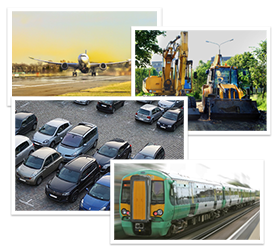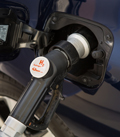Mobile Source Basics
What are Mobile Sources?
 Mobile sources include a variety of vehicles, engines and equipment, and can be classified into two major categories:
Mobile sources include a variety of vehicles, engines and equipment, and can be classified into two major categories:
On-road vehicles include: passenger cars and trucks, buses, commercial trucks, and motorcycles.
On-road vehicles are further classified by gross vehicle weight rating (GVWR):
-
Light Duty On-road vehicles are vehicles with a GVWR of 8,500 lbs or less.
-
Heavy Duty On-road vehicles are vehicles with a GVWR of 8,501 lbs or more.
Non-road vehicles include: aircraft, construction equipment, marine vessels, locomotives, lawn and garden equipment, and recreation vehicles.
Why do mobile sources matter?
Mobile source pollution accounts for a significant amount of all man-made air pollution emitted in Connecticut and throughout the Northeast. This pollution affects human health and our environment.
Emissions from mobile sources contribute to the formation of ground level ozone, which is the primary constituent of smog. According to the 2014 National Emissions Inventory (NEI), 21.4% of total volatile organic compound (VOC) emissions and 66.8% of total emissions of oxides of nitrogen (NOx) are shown to be transportation related. Studies have shown that high concentrations of ozone are harmful to human health, wildlife, crops, and buildings.
In addition, whether fueled by gasoline or diesel fuel, mobile sources are significant contributors to measured levels of particulate matter (PM). Mobile source particulate emissions consist mainly of very tiny, fine particles, also known as PM2.5, that are less than 2.5 microns in diameter. Fine particulate matter is a major health concern and contributes to unsightly haze.
Lastly, according to the US Energy Information Administration, transportation emissions of greenhouse gases (GHG) made up 43% of the GHG inventory in 2014, and are the leading source of GHG emissions in Connecticut.
How are mobile sources fueled?

Mobile sources in Connecticut typically burn gasoline or diesel fuel, but new vehicle technologies allow vehicles to operate with zero or low emissions by utilizing electricity or renewable fuels.
Learn more about these fuels, how they are distributed, and much more on our Fueling Mobile Sources webpage.
How can we reduce the impact of mobile sources?
There are many ways to reduce the environmental impact of mobile sources, both as a state, and as individual drivers:
-
Connecticut's Anti-Idling Law prevents the idling of vehicles for more than three minutes. Idling wastes fuel and money!
-
Driving an electric vehicle creates zero tailpipe emissions and can save drivers money on refueling, repairs, and maintenance! Visit EVConnecticut for more information on electric vehicles!
-
Replacement of outdated diesel engines reduces the impact of less effective emissions control technologies on heavy duty vehicle emissions. Check out Connecticut's DERA Grant Program and VW Settlement pages for information on funding to replace eligible diesel vehicles!
-
Emissions control technologies and idle reduction technologies such as auxiliary power units can help reduce emissions from heavy duty vehicles.
What is the future of mobile sources in CT?
Connecticut’s non-attainment status for ozone and maintenance status for particulate matter requires strategies designed to reduce emissions of NOx, VOCs, sulfur dioxide and PM2.5. The transportation sector is a significant source of these pollutants. Additionally, diesel-powered engines produce black carbon, a significant contributor to global warming, and emissions of toxic air pollutants, along with carbon dioxide (CO2) and PM2.5. Minimizing vehicle miles traveled (VMT) and reducing emissions from heavy duty vehicles are some of those important strategies that will improve Connecticut’s air quality.

State efforts to address Climate Change consider the substantial contribution of mobile sources to the state’s total annual emissions of CO2. The state's Comprehensive Energy Strategy (CES), revised in 2018, outlines steps the state is taking to combat climate change.
As a result of the most recent CES, the state is also developing an Electric Vehicle Roadmap for accelerating the deployment of EVs through policies and regulatory tools addressing transportation equity, purchasing incentives, consumer education, charging infrastructure, consumer protection, integration of EVs into the electric grid, utility investment, and rate design.
Content last updated February 3, 2020

